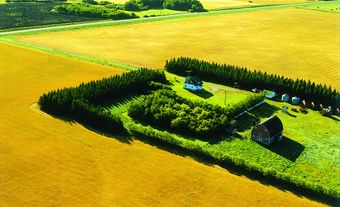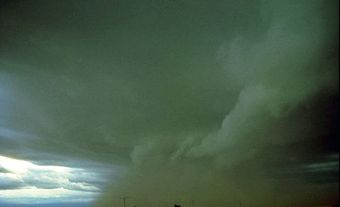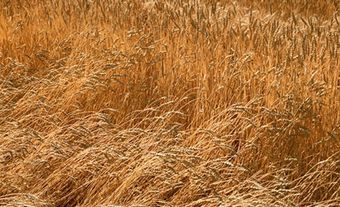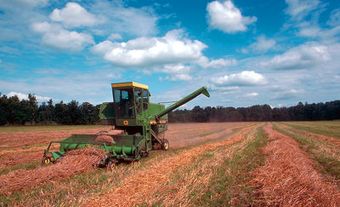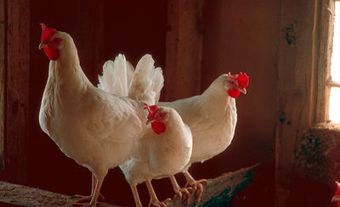Agriculture is the practice of growing crops and rearing animals mainly for food. Farmers also produce other items such as wool from sheep and CBD oil from hemp plants.
In Canada, agriculture is an important industry. Only about 7 per cent of Canada’s land can be farmed. Other marginal (poorer) land can be used to ranch cattle. Aquaculture operations are found on the East and West Coasts and in the Great Lakes. Some crops such as tomatoes, cannabis and flowers are grown in greenhouses in urban centres. Canadian agriculture faces many challenges. Some of these challenges concern crop protection, soil conservation, labour, climate change and health.
Click here for definitions of key terms used in this article.
This is the full-length entry about agriculture in Canada. For a plain-language summary, please Agriculture in Canada (Plain-Language Summary).
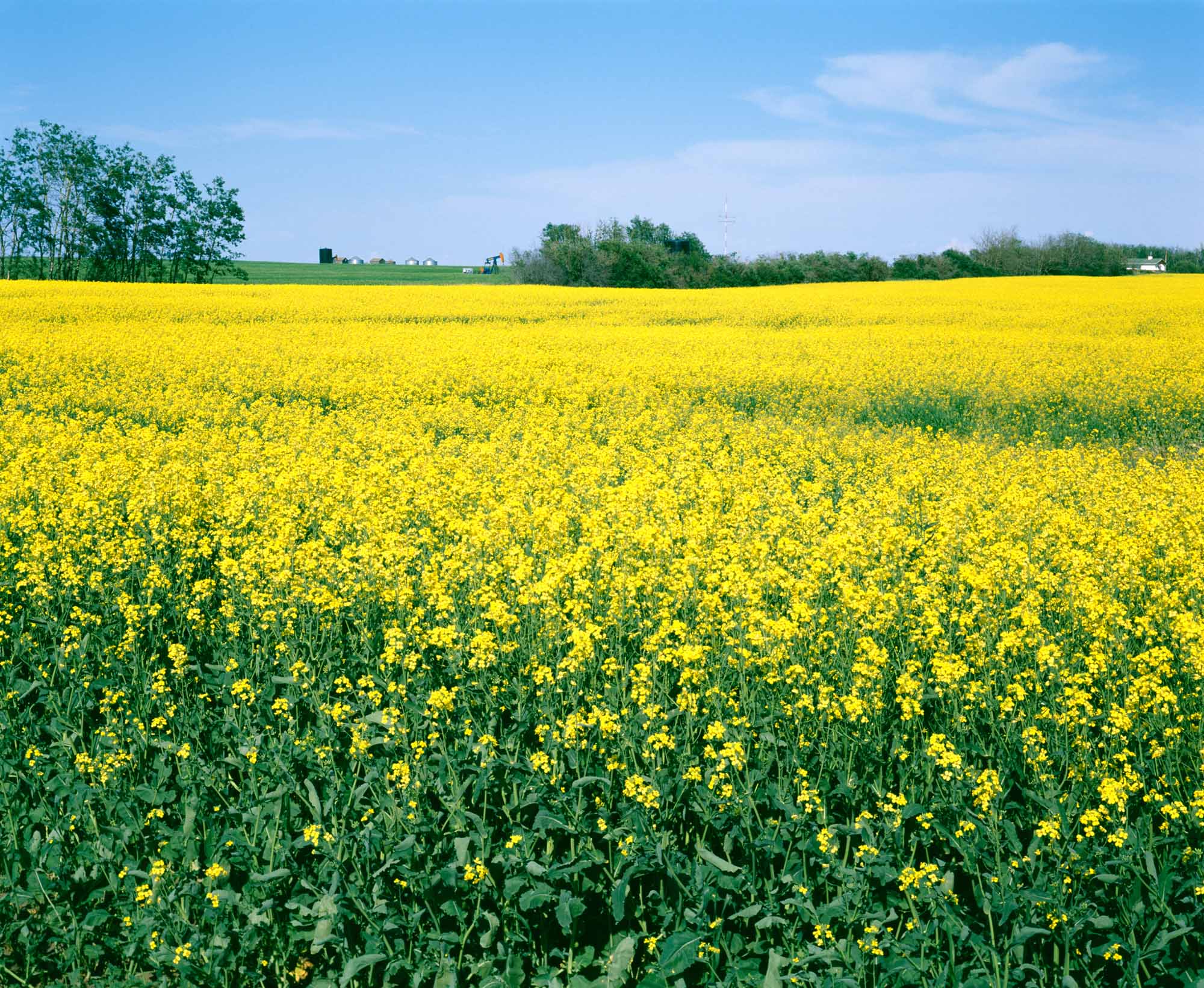
The Agriculture Sector in Canada
Agriculture is an important sector of Canada’s economy. As of 2018, there were 269,000 jobs in farming. Farmers, in turn, supply the much larger food production and processing industries (see Agriculture and Food).
Take the quiz!
Test your knowledge of food in Canada by taking this quiz, offered by the Citizenship Challenge! A program of Historica Canada, the Citizenship Challenge invites Canadians to test their national knowledge by taking a mock citizenship exam, as well as other themed quizzes.
Among Canada’s top agricultural products are canola, cattle and calves, beef and veal, vegetables and poultry. Canadian companies export crops, meat, maple syrup and many other products. Canada is a top exporter of agricultural products in the world. These exports were worth more than $60 billion in 2016.
Agriculture in Canada is varied and continues to change. Most of it is still traditional production of animals and crops for food. However, Canada now has a substantial amount of aquaculture. (Aquaculture is the cultivation of fish and other species that live in water). Another type of agriculture is called protected cultivation. This is the growing of food, flower, mushroom and cannabis crops in greenhouses or warehouses (see Greenhouse Crops). Some farmers also rear animals for fur or grow crops for various uses (e.g., fibre for composite building materials). Some Canadian food production is organic. This means that livestock and crops are produced under audited conditions (e.g., relating to the use of crop protection products or livestock access to the outdoors).
Canada’s federal and provincial governments provide funding to many industries, including agriculture. The current funding framework for agriculture is called the Canadian Agricultural Partnership. Government funds support agricultural research, export and trade. They also help farmers use new practices and technologies. Such advances can reduce environmental impact and increase efficiency. Other roles that governments play include setting regulations and overseeing food safety and inspection. (See also Food Legislation.)
Farmland and Farms
Only a small fraction (7 per cent) of Canada’s land area is suitable for farming. Most of this land is in Western Canada. However, marginal (poor) land can be used to ranch beef cattle. Farms vary according to topography, soil type and location (latitude).
The size of the average Canadian farm has increased over time. At the same time, the number of Canadian farms has decreased as farmers and corporations expand their business by buying other farms. The 2016 census counted 193,492 farms in Canada. The average Canadian farm is about 800 acres (a little more than 3 km2). Some crop farms in Western Canada cover thousands of acres.
Farming Regions of Canada
Most of Canada’s crop farming takes place in the Prairie provinces (Alberta, Saskatchewan and Manitoba). Alberta has the most beef cattle operations of any province. Saskatchewan produces the most durum wheat, canola and lentils. Manitoba has the most pig farms and is second in potato production. In British Columbia, farmers produce large amounts of fruit, vegetables, aquaculture products, eggs and poultry meat. That province also has the largest number of grape growers.

Image: Agriculture Canada.
Ontario has the most poultry farms of any province, is second in pig and dairy farms and has the largest number of cannabis-growing operations. Ontario farmers also produce the most corn and apples in Canada. Quebec is the largest producer of blueberries in Canada and has the largest number of dairy farms and cows. In Atlantic Canada, farming is split equally between crops and livestock (including aquaculture). Potatoes are a popular crop in this region. There are also several large food product manufacturers in Atlantic Canada (see Food and Beverage Industries).
Challenges and Progress in Canadian Agriculture
Canadian farmers are under pressure to produce more food. They must do this while caring for the livestock, land and water on their farms. Some areas in which farmers face challenges include crop protection, soil conservation, labour, climate change and health.
Crop Protection
To maximize the yield of field crops, crop farmers apply manure and/or fertilizer and crop protection products. These products include herbicides (for weeds), pesticides (for insects) and fungicides (for fungal diseases). Farmers work to prevent runoff from fields and other potential negative environmental effects of these products. Guidelines developed by industry and government specify the appropriate rates and conditions of their use. Farmers also use new, “greener” and more targeted products as they become available.
Soil Conservation
Crop farmers use soil conservation methods to protect their lands. One example is contour ploughing. Crop rows that run straight up a slope risk speeding erosion when heavy rain falls. These rows can act as channels down which rainwater carries soil. By contrast, ploughing that follows the contours of a slope leaves rows that run perpendicular to the flow of water. These rows will slow runoff and prevent erosion.
Labour Shortage
Canadian farms are in dire need of more workers. Many Canadians do not want to work on farms. A lot of farm work is seasonal and most Canadians want year-round work. In some cases, Canadians consider farm work too hard or the wage too low. In other cases, farms are located in remote areas where many do not wish to live. For years, Canadian farmers have therefore hired temporary workers from other countries. Almost 55,000 temporary foreign workers were employed in Canadian agriculture in 2018. (See Canada’s Temporary Foreign Workers Programs.)
Climate Change
Climate change affects farms; for example, heat and drought can negatively impact crops and livestock. At the same time, farming produces greenhouse gases (e.g., from tractors and livestock) that contribute to climate change. Canadian farmers have reduced their carbon emissions substantially over the last three decades. Their overall contribution including other greenhouse gases, however, has remained steady in the 21st century.
Farmers’ carbon reduction methods include more efficient barns and no-till cropping practices. They also use precision farming to consume less tractor fuel. Advancements in crop and animal genetics allow farmers to produce more food with less energy. The desire among consumers for local food means that more consumers are eating food that does not have to be shipped over long distances, saving fuel. New technologies also help farmers reduce their use of fuel, heat and electricity. For example, some use internet-based systems to better control barn conditions.
Natural hazards to farming
Heat, drought and disease are all examples of natural hazards to farming. Another natural hazard is flooding. Floods can jeopardize farmland along coasts and rivers, and in areas with heavy rain or snow. For example, spring floods can force farmers to delay planting by weeks. A crop that’s planted late may be more vulnerable to summer heat or autumn frost. Extreme weather events associated with flooding are likely to increase with climate change.
Animal and Human Health
Farmers, industry and governments have worked together over the past two decades to improve conditions for livestock. For example, Canadian egg farmers are phasing out the use of small cages for their hens. Evolving regulations from agencies such as Health Canada have played a role in many of these changes. In recent years, for example, farmers, industry groups and government have changed practices to reduce antibiotic use. This is because overuse of antibiotics in livestock farming threatens human health. (See Antibiotic Resistance in Canada.)
A style of agriculture called extensive farming can create healthy conditions for farm animals while minimizing pollution. Extensive farming involves the minimal use of resources such as crop protection products, labour and machinery. Animals typically have more space than they do on large industrial farms where the style of farming is considered “intensive.” Intensive farming relies heavily on resources to maximize the yield of a crop or productivity per animal. It requires more investment in the farm, but it typically uses less land to produce the same amount of food.

 Share on Facebook
Share on Facebook Share on X
Share on X Share by Email
Share by Email Share on Google Classroom
Share on Google Classroom

